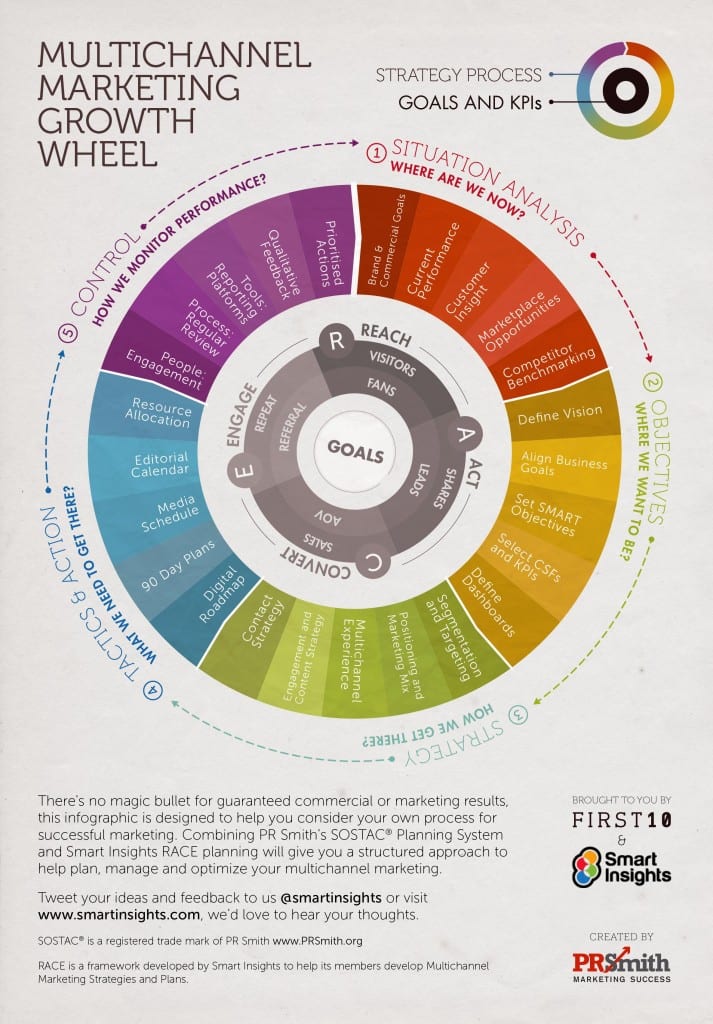Digital marketing strategy – What are the key stages?
Carrying on from our previous blog post ‘Digital marketing strategy part 1’ we’ll be outlining stage 3 and 4 of the multichannel marketing growth wheel infographic shown above. In this post we will be talking about the 3 stage process of digital marketing planning – segmentation, targeting and positioning and how you can plan your content in advance, in line with your other marketing activity.

Step 3: Strategy; How will you get there?
The three stage process
Segmentation, targeting & positioning (STP)
Segmentation, targeting, and positioning together comprise a three stage process. We recommend you target each particular market individually. You will miss opportunities to maximise your marketing results if your marketing strategy depends on targeting an entire mass market with no niche segmentation and no targeted messaging. Mass marketing is dead, after all, isn’t it??
How to segment
Segmentation is the first stage of the 3 stage process. It is arguably the most challenging but, if done properly, you’ll drive an increase in effective marketing and results. A common strategy is to group together markets who have similar age, characteristics, product type affinity, needs or buying patterns. However, we also suggest you look at motivational segmentation based on their interests and lifestyles – and their aspirations. If you identify what’s in it for each of them, you’ll be able to ensure your marketing answers the “Why” when it comes to why they should choose you or your product.
How to target
When it comes to targeting you need to dig to find out the nuggets that are going to help you resonate with your ideal customer. You should ask yourself “Who needs my product or service?” and “Who is most likely to buy it?” Questions to consider : Age, location, gender, income level, education level, occupation, marital status and ethnic background – but we always recommend you bind these up to a into a meaningful persona you can consider each time you are creating content for that type of customer.
What do we mean? Well, consider our performance development client here at Saucy Horse, Will It Make The Boat Go Faster? When we are creating digital marketing campaigns for this organisation, we will start with our target – let’s say, Hilary, Head of Transformation at a major retailer with plans to double their turnover in the coming year by acquiring new businesses in their sector. We will map out her challenges around that, her personal drivers, her pain – and we will gear our campaign around answering her questions at each stage that we are able to communicate with her from different channels. We will often end up with multiple personas for our clients, depending on the services they offer.
Sounds like hard work? Not really – it means you’ll end up with 5 niche and targeted campaigns rather than one nebulous and less effective campaign. It’s doing the hard work at the outset to make the selling easy.
You should also consider the psychographics of your market – the personality, values, opinions, attitudes, interests, hobbies, purchase choices and lifestyles of your ideal customer.
An example here is Virgin holidays – they segment holidays into 6 groups – and position them to appeal to specific target markets.
How to position
Product positioning – what does your target market think about your product compared to your competitor’s products? When you think of Rolls Royce, what do you think? Probably… high-end, credible, luxurious and exclusive. That’s their positioning. To put it bluntly, there’s no confusing the positioning of Rolls Royce and Hyundai.
The goal of product positioning is to keep your product on top of your customers’ mind when they’re considering buying whatever it is you sell. To be successful, product positioning must achieve these three objectives:
• Differentiate your product from the competition’s – really, WHY? should they buy from YOU?
• Address important customer buying criteria – their criteria, their need.
• Articulate key product (or company) characteristics – as benefits, not features
Turning Strangers to Visitors
How do you turn strangers into visitors? How do you find people who don’t know about you or your product, and bring them to into your orbit so that you can have some form of meaningful interaction with them? Social media is a highly effective tool at your disposal when it comes to acquisition of pre-qualified leads in your digital marketing strategy planning. There’s a way to leverage social media marketing successfully – you’ll need a defined strategy, desired outcome and ability to listen, learn and then ask the right questions. If you need help with creating that approach, you can start with our free social media marketing resources here.
Step 4: Tic-Tacs

Ah – we meant TACTICS!
There’s a wealth of planning and tactics you can use to ensure you reach your digital marketing goals. We recommend you use an editorial calendar. A good editorial calendar maps content production to your buyer personas, the engagement cycle (delivering appropriate content based on where the prospect is in the buying process), and the channels that they use at those various points. The calendar allows you to generate great quality content well in advance of publishing it – you’ll need to ensure it meets the all important criteria – always useful and relevant in your customers’ eyes.
We hope you’ve found our digital marketing strategy blog posts have helped you on your way towards effective digital marketing strategy planning in 2015. If you want more information about planning a strategy for your digital marketing arsenal, then our digital marketing specialists will be happy to help!




